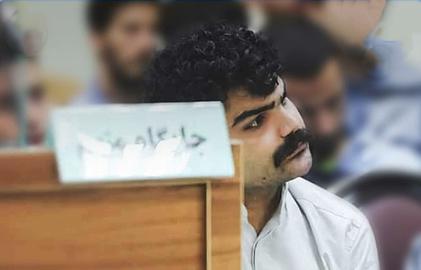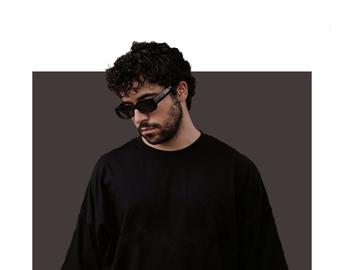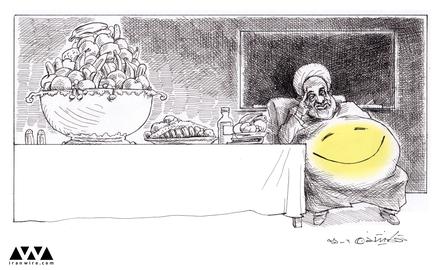She has painted her face red, with the numbers two and four on her cheeks in white. She has completely covered her hair with a red and black hat. She sits outside Tehran’s Azadi Stadium wearing a sports outfit. “I am going to drape the flag around me and go in,” she tells the camera.
The video was taken on Friday, May 13, just before a much-anticipated match between the Iranian football teams Persepolis and Rah Ahan.
When the 21-year-old posted the video on her Instagram page, it received nearly 3,000 “likes” and around 500 comments praising her courage.
Iran bans women from entering sports stadiums.
The young woman, who remains anonymous, has since published other pictures and videos of herself inside the stadium, which have been enthusiastically shared and republished across social networks.
In one of her Instagram posts, she talked about her love for the Persepolis football team.
In another video, she says, “Here we are in the stadium! I said that I would come!”
“Watching the game in the stadium is something else!” she wrote in the caption for the video. “I was there with all the difficulties posed by makeup, and the question of how to walk and talk. But those who found out that I was a girl treated me as a family member. There are a lot of restrictions in my country, but no wish is impossible. I wish for a day when there will be a stand for us women...I must thank the people who backed me up.”
Most of the commenters on social media have praised the young woman’s protest, and have asked her how she managed to pass through the gate. But some have warned that, with her pictures all over Internet, she is now bound to get into trouble. “You have become news,” one wrote. “Praise the Lord that you were not arrested! But be careful, because this is Iran.”
As for questions about how she got through the stadium gates, she wrote, “When you wish for something, you can get it if you try hard. In that searing heat at the stadium, where everybody was sitting there with T-shirts, I was wearing five shirts and five pairs of pants to cover my body so I could look like a boy. I was so afraid that I did not dare take anything off. The soldiers searched me and did their duty, but I had thought of everything.”
“Many say that my pictures are going to get me into trouble,” she wrote. “I really do not know how my pictures got around. If you are going to publish my pictures please do not make a serious issue out of it. I am a girl from an ordinary family, someone who wants to have a life. Nobody knew me or helped me. At that moment, I was a boy, and boys are allowed into stadiums. You can see how much makeup I used. My face was burning for four hours.”
Following the Islamic Revolution of 1979, women were banned from football stadiums. At times, they have been able to access volleyball or basketball competitions, but two years ago they were banned from those as well.
“Half of Liberty”
Female football fans have long objected to the stadium ban, but authorities will not budge. Hardline members of the parliament, as well as Friday Prayer leaders and conservative clerics in Qom, all want to keep women out of stadiums.
Their rationale is mainly religious. Many Islamic clerics say that allowing women into stadiums would contradict Islamic law, or sharia.
One hardline cleric, Grand Ayatollah Nouri Hamedani, has said the ban must remain in place because women should not look at the bodies of unrelated men, and because, "the presence of thousands of men and women at one gathering with their comings and goings would lead to them mixing together and to corruption, even if they sit separately."
Another prominent cleric, Grand Ayatollah Fazel Lankarani, has said, "It is clear in sharia that it is forbidden for women to look at the bodies of men, even if getting pleasure is not the intent."
Women’s rights activists began to press the issue of women in stadiums in the late 1990s with the White Scarves Campaign. Women would wear white headscarves and gather outside stadiums before matches to chant, “Half of Liberty is the Rights of Women!”
During the qualifying games for the 2006 FIFA World Cup, when Iran was competing against Qatar, women wearing white headscarves gathered outside the gates of Azadi Stadium in Tehran. On this one occasion, authorities briefly opened the gates to women, and they were able to watch the game that sent Iran to the World Cup. Former president Mohammad Khatami, a reformist, also attended.
Since that game, the ban has continued. But that year, even President Mahmoud Ahmadinejad, who is not known for his liberal attitudes, argued that women should be allowed into stadiums. Supreme Leader Ali Khamenei and the Iranian security establishment overruled him.
That year, Iranian director Jafar Panahi told the fictional story of a group of women getting arrested while trying to enter a stadium disguised as men in his film Offside. The film won the Silver Bear at the Berlin International Film Festival.
Following disputed presidential elections in 2009, Panahi was arrested and imprisoned for supporting opposition protests. Authorities have since banned him from making films or leaving Iran.
As I am finishing this report, I notice a shared social media message from a husband who is attending a match in Iran, and writes to his wife, “Be sure that I always long to sit with you at the stadium. I will always miss having you next to me.”
visit the accountability section
In this section of Iran Wire, you can contact the officials and launch your campaign for various problems

























comments